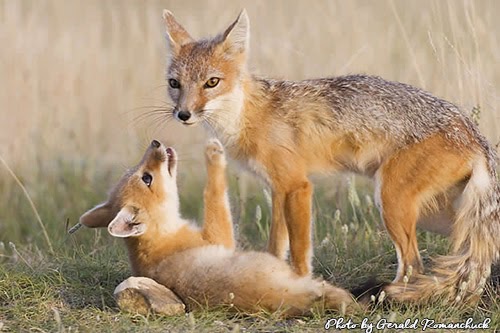- Scientific name: Vulpes velox
- SARA Status: Threatened
- COSEWIC Status: Threatened
- COSEWIC Range: Alberta, Saskatchewan
Once extirpated from Canada, the Swift fox has slowly been recovering its population following reintroduction programs starting from 1983 in Alberta and Saskatchewan.
About the size of a house cat and weighing an average of 2.3 kg, swift foxes are agile and able to run up to speeds of 50-60 km/hr. Their habitat consists of short-grass and mixed-grass prairie, which allows them to travel at their high speeds without being seen or impeded. Mainly staying near their den during the day, they are active at night, either hunting mice, rabbits, or insects, or looking for carrion.
The swift fox was listed as extirpated (locally extinct) from Canada in 1928, when the last known individual was captured in Saskatchewan. Their population dwindled due to the fast growth of large-scale agriculture, which diminished much of their habitat. Furthermore, many were killed from poison, which was instead meant to target coyotes and wolves.
The reintroduction program involved releasing captive-bred foxes from Alberta and wild captured foxes from the United States. Between 1983 and 1997, 942 swift foxes were released in southern Alberta and Saskatchewan with varying success, and by the year 2000, there was a self-sustaining wild population.
Swift foxes represent an indicator species, meaning that the health of their population is indicative of the health of the surrounding environment, including the landscape and other animals. The health of the grasslands and the health of the swift foxes are tightly connected. The fact that they disappeared shows how much native grasslands have suffered in recent decades. However, the successful reintroduction demonstrates there can be hope with intervention and management plans.
With more wildlife populations becoming at risk of extinction, the swift fox reintroduction program will be an important resource for endangered animals in the future.
Threats: Loss of habitat is what first led to the extirpation of the Swift Fox and it continues to be the main threat that the species is facing. The remaining grassland habitat that exists has become fragmented and much of it has been compromised due to activities such as plowing. Furthermore, the swift fox still falls victim to accidental trapping and poisoning by farmers and ranchers. Predation and pesticides also pose threats to the swift fox.
What’s being done: The swift fox is currently being protected under the federal Species At Risk Act (SARA), and under the Canada National Parks Act, as it occurs in Grasslands National Park. Under these acts, it is prohibited to kill, harm, or harass this species. There are also a number of Action Plans dedicated to the recovery of the species such as “Action Plan for Multiple Species at Risk in Southwestern Saskatchewan: South of the Divide” as well as “Multi-species Action Plan for Grasslands National Park of Canada”.

